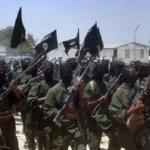Perpetrator Dashboard
This section disaggregates the data on global terrorism incidents down to an analysis of specific perpetrators. The nature of modern global terrorism is that a select few perpetrators commit a large number of annual incidents. This section also allows for greater understanding and context to be provided for the terrorist activities of consistent and emerging threats to global security in 2020 and beyond.
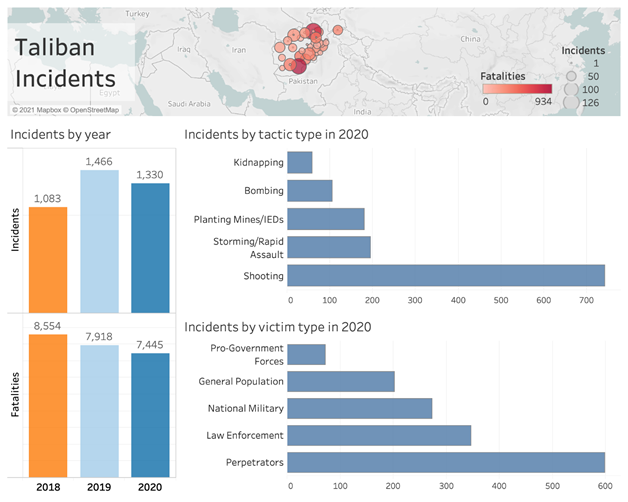
Taliban
In 2020, there were 1,330 incidents involving the Taliban, with 7,445 fatalities and 4,563 persons wounded. This constitutes a 9.2 percent decrease in incidents from 2019, as well as a 6 percent decrease in fatalities from 2019. All of the Taliban’s incidents were concentrated in Afghanistan in 2020. Common tactics the Taliban employed in incidents included shootings (56 percent), storming/rapid assault (15 percent), and planting mines/IEDs (14 percent).
Twenty-six percent of Taliban-involved incidents included law enforcement victims in 2020. Other prominent victims of Taliban violence included military (21 percent of incidents) and the general population (15 percent of incidents). Taliban personnel were reported to have been killed in 45 percent of the incidents attributed to the Taliban in 2020.
The provinces in Afghanistan that experienced the most Taliban incidents were Kunduz with 126 incidents (9.5 percent), Kandahar with 118 incidents (8.9 percent), and Ghazni and Helmand with 75 incidents each (each representing 5.6 percent of Taliban incidents).
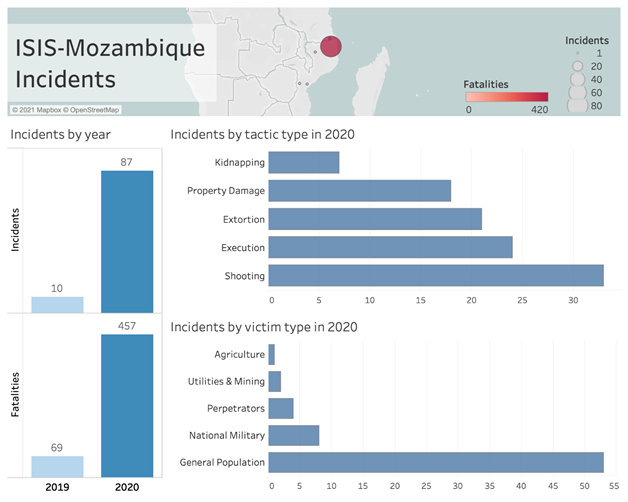
ISIS-Mozambique
In 2020, there were 87 incidents involving ISIS-Mozambique, with 457 fatalities and 29 persons wounded. This constitutes a 770 percent increase in incidents from 2019, as well as a 562 percent increase in fatalities from 2019.
Nearly all ISIS-Mozambique’s incidents were concentrated in Mozambique (86 incidents), with a single incident in Tanzania in 2020.
Common tactics ISIS-Mozambique employed in incidents included shootings (38 percent), executions (28 percent), extortion practices (24 percent), and property damage only (21 percent).
Sixty-one percent of ISIS-Mozambique-involved incidents in 2020 rendered general population victims. Other prominent victims of ISIS-Mozambique violence included military (9 percent of incidents), and 25 percent of incidents involved no actual victims. ISIS-Mozambique terrorists were reported to have been killed in 5 percent of the incidents attributed to them in 2020.
Most ISIS-Mozambique incidents in 2020 — 80 incidents (92 percent) — took place in Cabo Delgado.
On March 10, the Department of State announced the designation of the Islamic State of Iraq and Syria-Mozambique (ISIS-Mozambique) a foreign terrorist organization (FTO).

ISIS-DRC
In 2020, there were 276 incidents involving ISIS-DRC, with 1,435 fatalities and 156 persons wounded. This constitutes a 185 percent increase in incidents from 2019, as well as a 321 percent increase in fatalities from 2019.
All of ISIS-DRC’s incidents were concentrated in the Democratic Republic of Congo in 2020.
Common tactics ISIS-DRC employed in incidents included shootings (28 percent), extortion practices (19 percent), and kidnapping (14 percent).
Eighty-one percent of ISIS-DRC-involved incidents included general population victims in 2020. Other prominent victims of ISIS-DRC violence included military (24 percent of incidents). ISIS-DRC terrorists were reported to have been killed in 5 percent of the incidents attributed to them in 2020. Most ISIS-DRC incidents were concentrated in the Nord/North-Kivu province of the Democratic Republic of Congo with 257 incidents (93.1 percent), and Ituri with 17 incidents (6.2 percent).
On March 10, the Department of State announced the designation of Islamic State of Iraq and Syria-Democratic Republic of the Congo (ISIS-DRC) as an FTO.
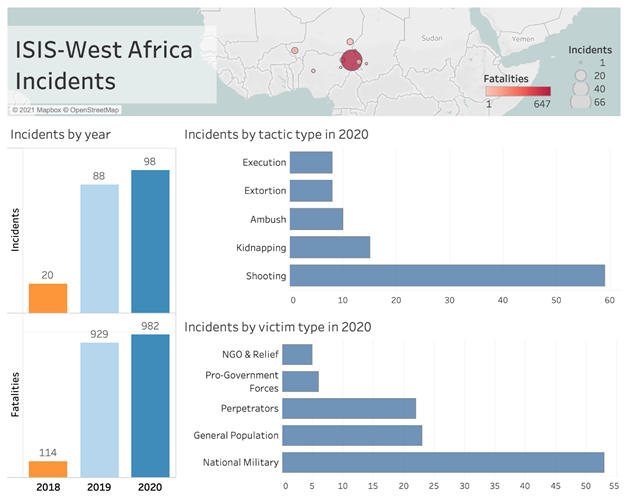
ISIS-West Africa
In 2020, there were 98 incidents involving ISIS-West Africa, with 982 fatalities and 397 persons wounded. This constitutes an 11 percent increase in incidents from 2019, as well as a 6 percent increase in fatalities from 2019.
ISIS-West Africa incidents were concentrated in Nigeria (77 incidents), Niger (14 incidents), Cameroon (4 incidents), and Chad (3 incidents) in 2020.
The states in Nigeria that experienced the most ISIS-West Africa incidents were Borno with 66 incidents (67.3 percent), Diffa with 7 incidents (7.1 percent), and Tillaberi with 6 incidents (representing 6.1 percent of ISIS-West Africa incidents).
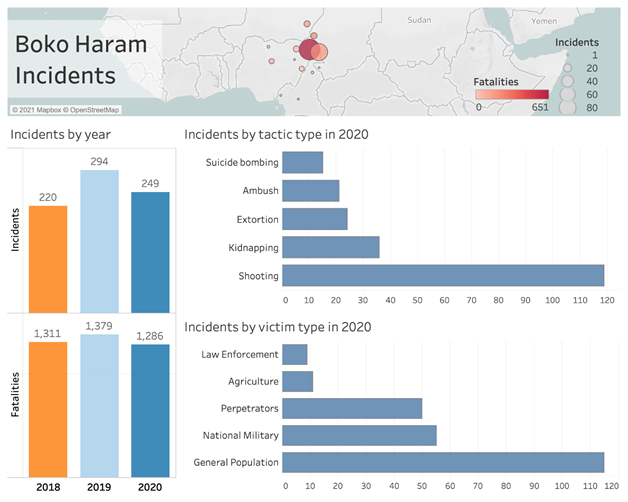
Boko Haram
In 2020, there were 249 incidents involving Boko Haram, with 1,286 fatalities and 631 persons wounded. This constitutes a 15 percent decrease in incidents from 2019, as well as a 6.7 percent decrease in fatalities from 2019.
All the Boko Haram incidents were concentrated in Nigeria (146 incidents), Cameroon (82 incidents), Chad (12 incidents), and Niger (9 incidents) in 2020.
Forty-six percent of Boko Haram-involved incidents included general population victims in 2020. Other prominent victims of Boko Haram violence included the military (22 percent of incidents) and persons in the agricultural profession (4 percent of incidents). Boko Haram terrorists were reported to have been killed in 20 percent of the incidents attributed to them in 2020.
The Nigerian states that experienced the most Boko Haram incidents were Borno with 113 incidents (45.4 percent), Extreme-Nord with 77 incidents (30.9 percent), and Lac and Yobe states with 10 incidents each (each representing 4 percent of Boko Haram incidents).
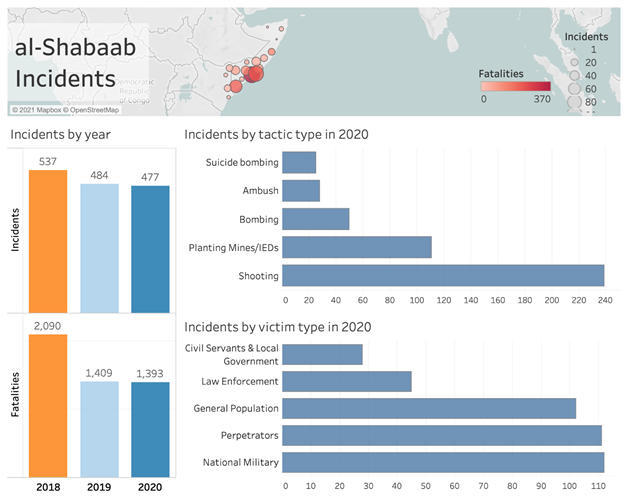
Al-Shabaab
In 2020, there were 477 incidents involving al-Shabaab, with 1,393 fatalities and 781 persons wounded. This constitutes a 1 percent decrease in incidents from 2019, as well as a 1 percent decrease in fatalities from 2019.
All the al-Shabaab incidents were concentrated in Somalia (433 incidents) and Kenya (44 incidents) in 2020.
The regions in Somalia that experienced the most al-Shabaab incidents were Shabeellaha Hoose with 99 incidents (20.8 percent), Banaadir with 90 incidents (18.9 percent), and Jubbada Hoose with 60 incidents (representing 12.6 percent of al-Shabaab incidents).
Geographic Trends of Terrorism

The map above shows the country hotspots of global terrorist incidents for 2020, as defined by the highest number of incidents and fatalities. As in the previous two years Afghanistan is at the top of the list. The continued expansion of terrorism in Africa — especially the Sahel, the DRC, and Mozambique — resulted in a dramatic increase in the number of incidents and fatalities in these countries and regions.
Profiles of Top 10 Countries/Regions With the Highest Number of Terrorist Incidents (in Order)
This section disaggregates the data on global terrorism incidents down to an analysis of specific geographic areas. The highly concentrated and localized nature of terrorism guides the selection of these countries and regions for further analysis and allows for crucial context to be provided to the great majority of incidents reported in 2020.
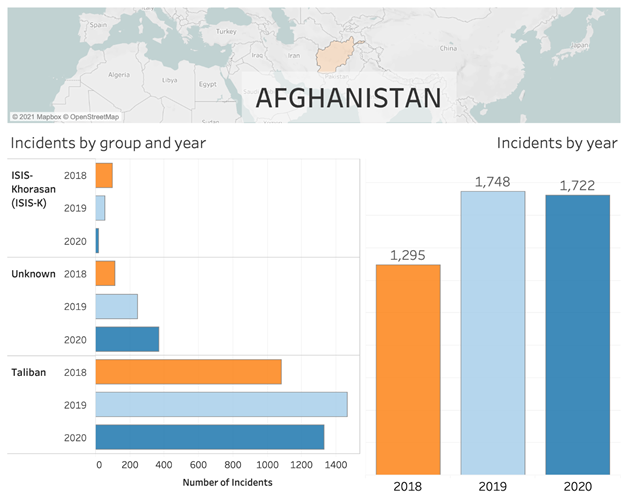
Islamic Republic of Afghanistan
In 2020, there were 1,722 incidents in Afghanistan, with 8,486 fatalities (29 percent of the global total of fatalities). This constitutes a 1.5 percent decrease in incidents from 2019 and a 2.4 percent decrease in fatalities.
The Taliban was the main perpetrator of incidents in Afghanistan in 2020, responsible for 77 percent of all incidents. ISIS-Khorasan was responsible for 1 percent of all incidents in the country. Twenty-one percent of incidents in Afghanistan were not attributed to a specific perpetrator group.
In Afghanistan, the districts that experienced the most incidents were Kandahar with 164 incidents (9.5 percent), Kunduz with 132 incidents (7.7 percent), and Kabul with 127 incidents (7.4 percent).

Syrian Arab Republic
In 2020, there were 1,332 terrorist incidents in Syria, with 3,172 fatalities (11 percent of the global total of fatalities). This constitutes a 26.7 percent increase in incidents from 2019 and an 8.6 percent increase in fatalities, as seen in Tables 3.1 and 3.2 previously.
ISIS was the main perpetrator of incidents in Syria in 2020, responsible for 15 percent of incidents. The next-most-active group was Hay’at Tahrir al-Sham, responsible for 10 percent. Fifty-eight percent of incidents were attributed to Unknown. In total, there were 44 different perpetrator groups active in Syria in 2020.
The Syrian provinces that experienced the most incidents were Aleppo with 290 incidents (21.8 percent), Dayr az Zawr with 239 incidents (17.9 percent), and Idlib with 197 incidents (14.8 percent).

Democratic Republic of Congo
In 2020, there were 999 incidents in the Democratic Republic of Congo (DRC), with 3,497 fatalities (12 percent of the global total of fatalities). This constituted a 160 percent increase in incidents over 2019, and a 213 percent increase in fatalities.
ISIS-DRC (labeled in past Annexes as Allied Democratic Forces) was the main perpetrator of incidents in the DRC in 2020, responsible for 28 percent of incidents. The Cooperative for the Development of the Congo (or CODECO) was responsible for 12 percent of incidents. Other groups — such as the Reformed Nduma Defense of Congo and the Alliance of Patriots for a Free and Sovereign Congo — were also active. Seven percent of incidents in the DRC could not be attributed to a perpetrator group.
The states in the DRC that experienced the most incidents were Nord-Kivu with 622 incidents (62.3 percent), Ituri with 155 incidents (15.5 percent), and Sud-Kivu with 153 incidents (15.3 percent).

Republic of India
In 2020, there were 679 incidents in India. There were 567 fatalities (2 percent of the global total of fatalities). While India was in the top 10 countries for most terrorism incidents, it is not in the top 10 for fatalities. There was a 3.7 percent increase in terrorism incidents over 2019, and a 3.7 percent decrease in fatalities from 2019.
CPI-Maoist was the main perpetrator of incidents in India in 2020, responsible for 44 percent of all incidents. Lashkar-e-Tayyiba (LeT) was responsible for 6 percent of all incidents. Hizbul Mujahideen was responsible for 6 percent of all incidents. Jaish-e-Mohammed (JeM) was responsible for 3 percent of all incidents. And 29 percent of incidents were not attributable to any perpetrator group.
The states in India that experienced the most incidents were Jammu and Kashmir with 257 incidents (37.8 percent), Chattisgarh with 145 incidents (21.4 percent), and Jharkand with 69 incidents (10.2 percent).
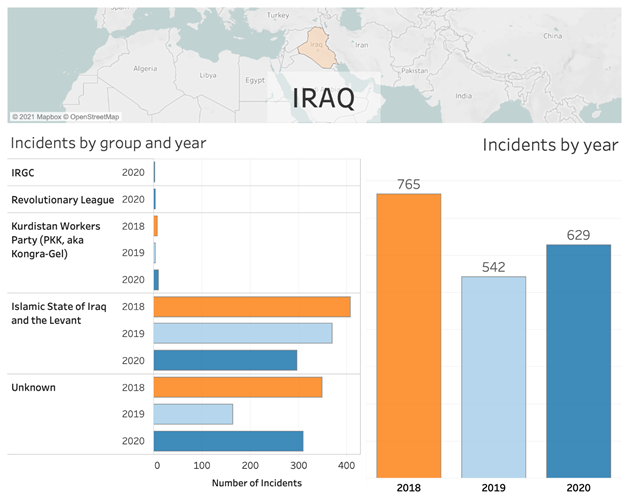
Republic of Iraq
In 2020, there were 629 incidents in Iraq, with 563 fatalities (2 percent of the global total of fatalities). This constitutes a 16 percent increase in incidents from 2019, but a 13.9 percent decrease in fatalities from 2019. While Iraq made the top 10 list for terrorism incidents in 2020, it did not make the top 10 list for countries with the most fatalities.
ISIS was the main perpetrator of incidents in Iraq in 2020, responsible for 47 percent of all incidents. The PKK was responsible for 2 percent of incidents. Other active perpetrator groups — such as Revolutionary League (Usbat Al-Thairen), Islamic Revolutionary Guard Corps, Qassim al-Jabbarin Brigade, and Hizballah-Iraq — were collectively responsible for 2 percent of the incidents. Forty-nine percent of incidents in Iraq were not attributed to a particular perpetrator group.
The provinces in Iraq that experienced the most incidents were Diyala with 161 incidents (25.6 percent), Baghdad with 120 incidents (19.0 percent), and Kirkuk with 84 incidents (13.4 percent).

Federal Republic of Somalia
In 2020, there were 504 incidents in Somalia with 1,458 fatalities (5 percent of the global total of fatalities). This constitutes a 3.7 percent increase in incidents from 2019, as well as a 7.0 percent increase in fatalities from 2019.
Al-Shabaab was the main perpetrator of incidents in Somalia in 2020, responsible for 86 percent of incidents. ISIS-Somalia was responsible for 1 percent. Thirteen percent of incidents in Somalia were not attributed to a perpetrator group.
In Somalia, the provinces that experienced the most incidents were Banaadir with 110 incidents (21.8 percent), Shabeellaha Hoose with 105 incidents (20.8 percent), and Jubbada Hoose with 64 incidents (12.7 percent).

Federal Republic of Nigeria
In 2020, there were 390 incidents in Nigeria, with 2,322 fatalities (8 percent of the global total of fatalities). This constitutes a 14 percent decrease in incidents from 2018, as well as a 14 percent decrease in fatalities from 2019.
Boko Haram was the main known perpetrator of incidents in Nigeria in 2020, responsible for 37 percent of all incidents. ISIS-West Africa was responsible for 21 percent of all incidents. As noted earlier, local sources do not always differentiate between Boko Haram and ISIS-West Africa. Other groups such as the Zamfara Militants and Ansaru were also active in Nigeria. Eight percent of incidents in Nigeria were not attributed to a particular perpetrator group.
The Nigerian states that experienced the most incidents were Borno with 184 incidents (47.2 percent), Kaduna with 84 incidents (21.5 percent), and Benue with 23 incidents (5.9 percent).

Republic of the Philippines
In 2020, there were 362 incidents in the Philippines, with 506 fatalities. This constitutes less than a 0.8 percent increase in incidents over 2019. While the Philippines made the top 10 list of countries with the most terrorism incidents, it did not make the list of top 10 countries with the most fatalities.
The Communist Party of the Philippines/News People’s Army was the main perpetrator of incidents in the Philippines in 2020, responsible for 64 percent of all incidents. ISIS-Philippines was responsible for 16 percent of incidents. Bangsamoro Islamic Freedom Movement was responsible for 9 percent of incidents. Other groups such as the Moro Islamic Liberation Front were also active in the Philippines. Five percent of incidents in the Philippines were not attributed to a specific perpetrator group.
In the Philippines in 2020, the provinces that experienced the most incidents were Maguindanao with 44 incidents (12.2 percent), Sulu with 31 incidents (8.6 percent), and Negros Oriental with 19 incidents (5.2 percent).
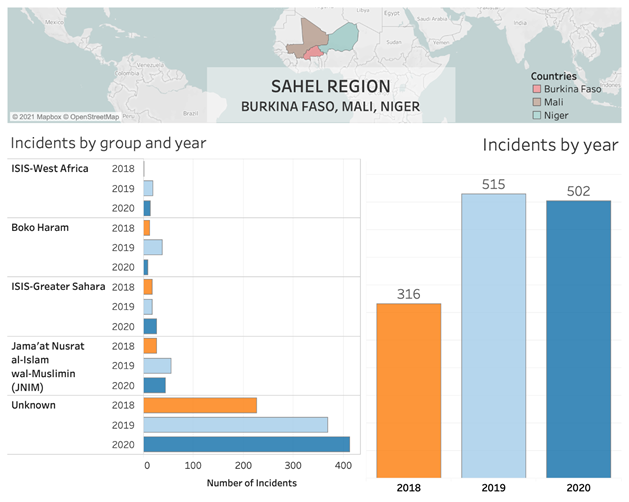
The Sahel Region
In the Sahel, terrorist groups — including affiliates and adherents of al-Qa’ida, ISIS, and nonaligned groups — have expanded their operations in north and central Mali and the tri-border region of Burkina Faso, Mali, and Niger. The number of incidents nearly doubled in 2019 and continued to climb in 2020.
In 2020, there were 502 incidents in the Sahel, with 3,013 fatalities (10 percent of the global total). This constitutes a 2.5 percent decrease in incidents from 2019.
Burkina Faso
In 2020, there were 197 incidents in Burkina Faso with 891 fatalities. This represents a 4.8 percent decrease in terrorist activity from 2019 and an 8.8 percent decrease in fatalities over 2019.
Jama’at Nusrat al-Islam wal-Muslimin was the main perpetrator of incidents in Burkina Faso in 2020, responsible for 13 incidents (7 percent). ISIS-Greater Sahara was responsible for seven incidents (4 percent). Eighty-nine percent of incidents in Burkina Faso could not be attributed to a particular perpetrator group.
In Burkina Faso, the provinces that experienced the most incidents were Tapoa (13.2 percent), Soum (13.2 percent), and Bam (10.2 percent).
Republic of Mali
In 2020, there were 253 incidents in Mali with 874 fatalities. While Mali experienced a 12 percent increase in terrorist activity from 2019, it experienced a 17.4 percent decrease in fatalities from 2019. Notably, Mali was the country with the 10th-most terrorism incidents in 2020, and the country with the 8th-most fatalities in 2020.
Jamaat Nusrat al-Islam wal-Muslimin was the main perpetrator of incidents in Mali in 2020, responsible for 30 incidents (12 percent). ISIS-Greater Sahara was responsible for 18 incidents (7 percent). Eighty-three percent of incidents in Mali were not attributed to a specific perpetrator group.
In Mali, the provinces that experienced the most incidents were Mopti (49.0 percent), Gao (11.5 percent), and Tombouctou (6.7 percent).
Republic of the Niger
In 2020, there were 52 incidents in Niger, with 493 fatalities. This constitutes a 37 percent decrease in terrorist activity from 2019 and a 51 percent increase in fatalities from 2019.
ISIS-West was the main perpetrator of incidents in Niger in 2020, responsible for 14 incidents (27 percent). Boko Haram was responsible for 9 incidents (17 percent). Fifty percent of incidents in Niger could not be attributed to a specific perpetrator.
In Niger, the provinces that experienced the most terrorism were Diffa (42.3 percent), Tillaberi (36.5 percent), and Tahoua (7.7 percent).


